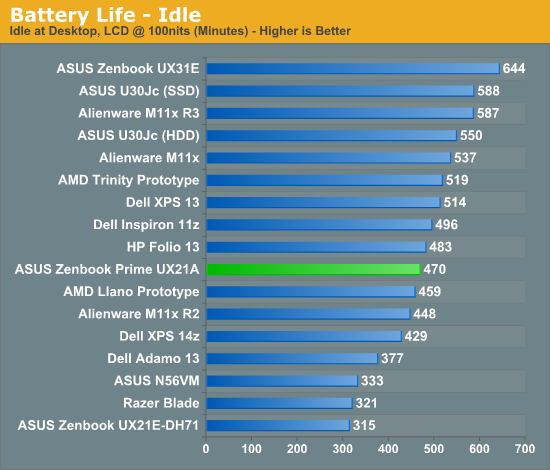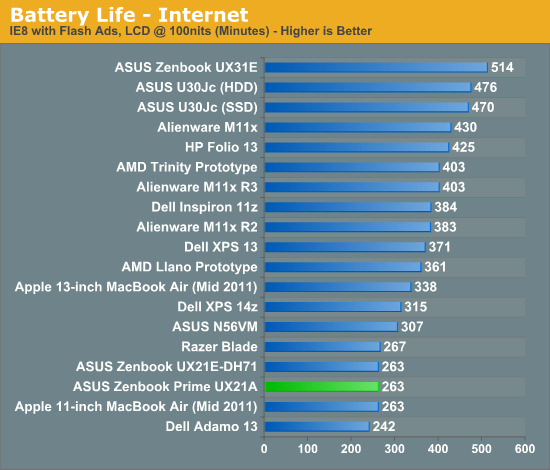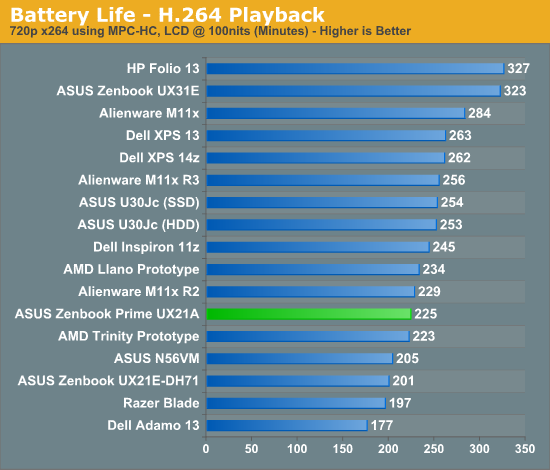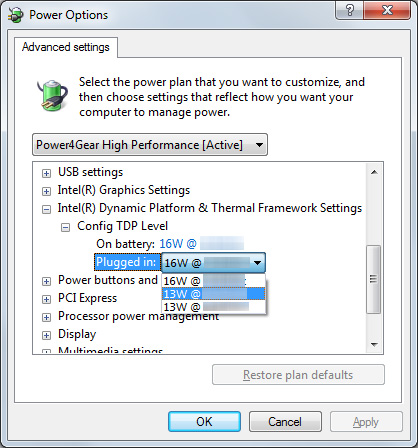ASUS Zenbook Prime (UX21A) Review: The First of the 2nd Gen Ultrabooks
by Anand Lal Shimpi on May 22, 2012 2:46 PM EST- Posted in
- Laptops
- CPUs
- Asus
- Ivy Bridge
- Zenbook
- Zenbook Prime
- Ultrabook
- Notebooks
Battery Life
Generally speaking, the 11-inch Zenbook Prime delivers about the same amount of battery life as its predecessor. For some reason we're able to hit much longer idle battery life on the Prime than the original Zenbook although I'm still trying to find out why. There's also an 11% improvement in our x264 playback test, but on average I'd expect to see similar battery life to the Sandy Bridge model - just with better performance. Note that these results also come despite the fact that ASUS is driving a much higher resolution, and presumably higher power, display than the original Zenbook.



The Zenbook Prime bucks the trend Jarred saw with the first Ivy Bridge notebook review where battery life took a small step backwards. These results bode well for future Ivy Bridge notebooks and Ultrabooks. It still remains to be seen if Intel's 22nm process will actually give us a battery life advantage in any notebook compared to its predecessor. It's possible that we are seeing some of the benefits of 22nm here already and they are simply offset by the more power hungry display. With the move to 22nm Intel should have a better hold on active power and leakage, but it's always possible that we'll have to wait until Haswell for the process to really be exploited.
Just like last time, ASUS has a couple of widgets to quickly change between power settings. The instant on widget lets you switch between suspend to RAM and suspend to disk modes. The former is expected to deliver up to 2 weeks of standby battery life, while the latter can push up to 150 days. I didn't have the time to test these claims (life is short, I draw the line at spending it testing claims of 150 day standby battery life). ASUS once again includes a counter that estimates how long your system will last in either mode based on current charge levels and power usage.
The next widget is a quick tool to let you switch between high performance and battery saver Power4Gear power profiles. You can customize these profiles via the Windows control panel, but it's nice to have a button on the desktop that lets you quickly switch between them.
Configurable TDP
One feature of Ivy Bridge that we haven't been able to test until now is configurable TDP. While most Ultrabook CPUs ship with a 17W TDP, that's mostly an arbitrary thermal/power rating. If an OEM wants to design a chassis that can only accept a 13W part it previously had to hope that Intel would make such a thing. Alternatively, the OEM could underclock/undervolt a 17W chip on their own and hope to mimic Intel's validation and deliver a 13W configuration of their own. The former requires that a significant number of OEMs demand the part, while the latter is just too risky for the larger OEMs (get too aggressive on the undervolting side and end up with a bunch of unstable systems). The solution Intel proposed with Ivy Bridge is configurable TDP. For Ultrabooks this means you can set a 17W part to 13W.

Currently the setting is hidden away in Windows 7's power management settings. Once again I've had to censor the clock speeds here due to Intel's Ultrabook embargo:
You can map the 13W settings to the battery saver profile and then, at the click of a button, have a 13W Zenbook Prime instead of a 17W model. The difference in performance isn't significant however:
| ASUS Zenbook Prime Configurable TDP Performance - Cinebench 11.5 (Multithreaded) | |||||||
| 16W - Max Freq | 13W - Mid Freq | 13W - Lowest Freq | |||||
| ASUS Zenbook Prime UX21A | 2.79 | 2.67 | 2.67 | ||||
I'm still running battery life tests to quantify the impact on power consumption, but it's conceptually a neat thing to see in action finally. I suspect configurable TDP is going to play a major role with Haswell and convertible/dockable Ultrabook-tablet hybrids.
Thermals and Noise
As with most high performance notebooks that are this thin, cooling is difficult. Under load the fans in the Zenbook Prime are definitely audible, but in general ASUS does a better job cooling everything inside the Zenbook Prime than Apple does in the MacBook Air. I suspect much of this boils down to how aggressive Apple is about keeping fan speed/noise down compared to ASUS' desire to maintain a certain temperature level inside the chassis.










192 Comments
View All Comments
Impulses - Tuesday, May 22, 2012 - link
This is not even close to being a gaming laptop...maniac5999 - Tuesday, May 22, 2012 - link
Quick question, but how decent would the UX32 be at light gaming? (Civ5 on low, SC2 on medium, etc) I'm having some trouble pegging it's performance down, even with the help of Notebookcheck.tipoo - Wednesday, May 23, 2012 - link
The review says says 20 is acceptable for an ultramobile on a slow action game like D3, not that it's a killer gaming experience.ananduser - Wednesday, May 23, 2012 - link
If 20fps is acceptable then 720p resolution is acceptable as well.JarredWalton - Wednesday, May 23, 2012 - link
I've been poking around at Diablo III on another laptop today; to say that it's the greatest experience ever on Intel's HD 4000 would be a stretch, but it's not horrible either. It looks like the worst offender for poor performance on HD 4000 is the shadow setting; at low and 768p I got ~24 FPS for a test sequence, while a bump to 900p with most other detail options at "max" only dropped performance slightly. Turn on high shadows though and you're looking at a drop to about half the frame rate (or 1/3 lower with medium shadows).One thing you have to understand with regards to Diablo III and what constitutes acceptable performance is that it's not a twitch shooter, and the mouse cursor is separate from the frame rate. If you're very tolerant, you could even play with frame rates in the teens, but I'd suggest 20 FPS as the bare minimum. Civilization V is similar in this regard, and it's slow-paced (turn based) enough that even 10 FPS could be livable for some. It all depends on what you're willing to live with. Minimum detail and 768p in Diablo III does look pretty lousy, though -- particularly the lack of shadows, which is one of the biggest boosts to performance.
Now, if you've actually played the game on HD 4000 and want to contribute something to the discussion, that would be fine. Since it sounds like you've never played the game in the first place (at least not on moderate/low-end hardware), though, I'm not sure there's much point in you opining on how "20fps is NOT playable". For most other games, you would be correct, but for Diablo III you're just guessing...wrongly I might add. I played through a whole section with an average of 18FPS and found it acceptable for someone that's not hardcore. (Note that that was with most detail settings maxed at 900p.)
Now I need to go install it on Trinity and a couple other laptops to see how the experience compares. Oh, and FWIW, I'm not sure Diablo III is adding much to the gaming experience that's wildly improved from Diablo II, other than finally supporting higher resolutions. 12 years and this is what they have to show for it. Hmmm....
gorash - Tuesday, May 22, 2012 - link
Soo, ASUS has managed to ship a laptop with a 1080p IPS display without breaking the bank. Why couldn't the other manufacturers do the same?Reflex - Tuesday, May 22, 2012 - link
1) That is the first ultrabook I have ever considered to be interesting enough to consider buying, especially the 13.3" model with nV graphics/1080p LCD2) This is the first Asus laptop I'd consider owning, I've never been impressed with their build quality.
Really I wish it had 8GB as an option, just for longevity's sake(I tend to run a laptop a minimum of 5 years) but at 6GB its probably close enough. Very impressive and reasonably priced too. Want to see the build options and price on the 13.3" version.
Also, can the 24GB built in flash cash be used in conjunction with a hybrid HDD from Seagate? Or will that be an issue? What if you put in a SSD?
dagamer34 - Tuesday, May 22, 2012 - link
There's little point in double caching an SSD.Reflex - Wednesday, May 23, 2012 - link
Correct, but thats the thing, the cache is built in. What happens if you install a SSD? Does it get disabled?Also, there might be some point. This cache is SLC flash, if its utilized extensively it could extend the usable life of the installed SSD by preventing unnecessary writes...
sicofante - Thursday, May 24, 2012 - link
Wouldn't this take 8GB modules? That would make 10GB of RAM, which is pretty future proof for me.If it has 24GB built-in flash, I'd ask for a very big HDD, say 1TB? It would be cheaper than any SSD model and, with those 24GB acting as a cache, fast enough for everyday tasks. Do they offer such a combination?